
UNITED STATES HARBOR DEFENCES - USCG CABLE SHIP PEQUOT

UNITED STATES
HARBOR DEFENCES - USCG CABLE SHIP PEQUOT
The Captain’s Corner
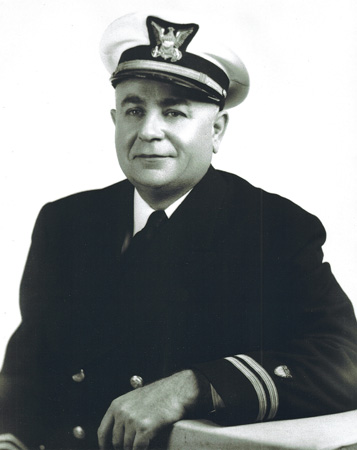 |
A Life At Sea – The Lars Anton Sande Story
Based Upon Information and Recollections
Provided by Ted Sande, Lars A. Sande's Son.
(Portrait above courtesy of Ted Sande)
Please note: the webpage United States Coast Guard Cableship Pequot details the history and the role of the Pequot in laying and repairing indicator loop cable for antisubmarine harbor defense in WW II. The Captain of the Pequot in WW II was Lars Anton Sande and this current webpage provides a retrospective on his life. However, this page is more than just a tribute to one man; it honors not only Lars Sande's memory but acknowledges the thousands of other Americans that pulled together during the darkest hours of World War 2.
Lars Anton Sande, was born in Bergen, Norway on June 17th 1894 to Klaus Larsen Sande, a baker, and Malene Olsdaughter, a farmer’s daughter. He was the eldest of four children.
His brother, Ole, was a merchant sailor who died at sea in the Gulf of Mexico before 1920. His sister Katrina, died with child during the influenza pandemic of 1917-19, and his youngest brother Klaus Martin, followed him to the United States where he served one enlistment in the Coast Guard and then returned to civilian life in New York City where he died in the 1970s.
|
|
|
The Seaport City of Bergen Norway 1880-1900. (Library of Congress) |
“Apparently, in addition to working as a baker my grandfather Sande had several commercial enterprises, including one in the fishing industry,” Ted Sande recalls. “He died in the winter of 1902 when while working in the fjords he slipped on some ice and fell from a barge transporting fish. My father was eight years old at the time. He attended public school from ages 7 to 12 and completed the full course of study.
As I recall, my father was called "Sande" by many of this friends. In the Norwegian family and among the Norse friends he was usually "Anton". My mother called him "Anton". I called him either "Dad" or "Pop". I don't remember anyone ever calling him "Lars" Ted adds.
After Sande completed his schooling he worked at a local department
store for several years, then around 1910,
when he turned 16, he went to sea as an ordinary seaman. During this era sailors
climbed up rope ladders to unfurl and trim huge canvas sails while
hanging on swaying masts and rigging 50 to 60 feet in the air. They
worked day and night and in all weather conditions. For a young man
it must have been very exciting, yet very hard and dangerous work.
.
|
|
|
|
Hamburg 1907. (Vintage Postcard) |
Port of Hamburg and Elbe River circa 1900. (Vintage Postcard) |
His home port for the next several years, until the start of World War I, was Hamburg, Germany. From there he sailed on various sail and steam vessels, including one of the last of the square-rig grain ships that made the long trek to Australia and back. Every year, until the outbreak of World War II, sailing ships came to Australia’s Spencer Gulf to take aboard loads of grain. That trade, which brought grain from Australia to Europe every year, was the last of the deep-water runs where sailing ships could compete with the steam powered freighters.
|
|
|
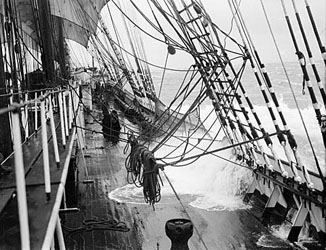 |
|
The Parama, one of the last Square Rigged Grain
Ships. |
The Grain Racing Ship Pamir. |
The Parama on a grain run under heavy sail with the decks awash. (National Maritime Museum) |
These tall ships left Europe in September or October and reached South Australia around December or January, having sailed around Africa and eastwards across the Indian Ocean. They then spent a few weeks loading grain in Port Victoria or Port Lincoln, and then went back around Cape Horn. The "racing" of these long haul sailing cargo vessels came from the lively competition to see which ship would be the first to market in Europe with the new season’s grain.
By 1917 Sande had immigrated to the United States and was residing in New York City and sailed from there on different merchant ships. Ted remembers, “My father told me that during this period, while he was in the Merchant Marine near the latter part of WWI, he almost got inducted into the U.S. Army, but that makes no sense to me since he was not a U. S. citizen at the time.”
Lars Anton Sande enlisted as a seaman in the United States Coast Guard on January 5th 1920 and shipped aboard the cutter Seneca in New York City where he became a U.S. Citizen in May 1922, roughly two and a half years after his enlistment.
|
|
|
The US Coast Guard Cutter Seneca. (US Coast Guard) |
“There were a number of Scandinavians who enlisted at the time my father joined the service,” Ted writes. “ His closest friend in the Coast Guard was Andrew Ramstad, a Norwegian who had settled in San Francisco, but served on the East Coast. For years our families shared Christmas Eve dinners together with a traditional salted lamb ribs dish among other tasty Nordic treats - no Lutefisk for us!”
Due to his prior service in the merchant marine, Sande rose quickly through the ratings. He was made a Chief Petty Officer (Boatswain) in 1925 and a Warrant Boatswain in March 1927.
|
|
|
Chief Petty Officer Sande
1925. |
“The Coast Guard that I recall was a relatively small, highly collegial service,” Ted remembers. “It seemed that no matter where he was stationed, New London, Boston, Providence, or New Orleans, my father knew someone from an earlier assignment. In the latter part of the 19th century and through the 1920s there were quite a few Irishmen in the service; so much so that I remember the Coast Guard’s nickname was “Hooligan’s Navy.”
During the 1920s, during a very colorful chapter in the Coast Guard’s history, Sande served on a variety of small patrol boats and large destroyers off the coast of New Jersey and around New York Harbor as part of the effort to keep illegal liquor from coming ashore during Prohibition.
|
|
|
|
A typical small Coast Guard Patrol boat of the 1920s that chased Rum Runners. These 75 foot patrol boats were also known as "six-bitters". (USCG Photo) |
Crew from a four stacker searching a Rum Runner. |
With its many inlets, points, and coves, the coast of New Jersey stood out as a haven for the Rum-Runners. A line of large vessels loaded with barrels of booze took up station in international waters off the coast of New Jersey and New York. Called the “Rum Line,” as many as 60 ships at a time would line up offshore. They sold liquor to operators of hundreds of small high speed boats that ran the Coast Guard’s patrol boat gauntlet to reach isolated locations along the coast where men were waiting with trucks to load up the hooch and drive off into the night.
|
|
|
Warrant Boatswain L.A. Sande 1927. (Ted Sande) |
At the end of World War I, the U.S. Navy transferred a number of “four stacker” destroyers to the Coast Guard for use during prohibition. “During the second half of the 1920s my father served on a number of these long, narrow beamed ships which rolled savagely in heavy seas,” Ted explains, “probably in part, because he was immune to seasickness.”
|
|
|
|
Eight “Four Stacker” Tucker Class Destroyers under construction At the New York Shipbuilding Company 1919. (U.S. Naval Historical Center Photograph NH 42530) |
The Philadelphia Navy Yard - WWI Era. |
Sande was based at the Philadelphia Navy Yard during this time and in addition to his Coast Guard rankings in1929 he earned an unlimited Merchant Marine 2nd Mate license to serve on ships of any tonnage on any ocean. According to his service record here are some of the ships Sande served on during prohibition and before World War II.
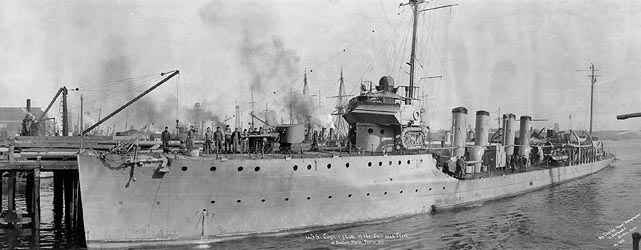 |
| USS Conyngham (DD 58) a 1090-ton Tucker class destroyer. US Naval Historical Center. (Crosby Collection) |
|
|
|
|
The USCGC Morris (WSC-147) 125 foot’ Active Class Patrol Boat which operated against rum runners in the 1920s. (US Coast Guard) |
The USCGC Marion research ship. |
The Marion was assigned oceanographic research north to Baffin Bay and Davis Strait, to seek information on the currents of the northern waters to find the sources of the icebergs which found their way to the Grand Banks and the North Atlantic steamer lanes. After extensive alterations for cold weather operations, Marion left Boston Navy Yard on July 11th 1928. This 8,100-mile expedition established that most icebergs originated in western Greenland, and that the number of icebergs which would reach the Grand Banks could be reasonably predicted. It is speculation if Sande served aboard Marion during this cruise, however if he did, it was invaluable experience that served him well during WWII as skipper of the Pequot in those same icy North Atlantic waters.
|
|
|
Sande served aboard an Eagle Class patrol boat. Here is Eagle #42 one of about112 “Eagle” Patrol Boats built during WWI. (Dictionary of American Naval Fighting Ships) |
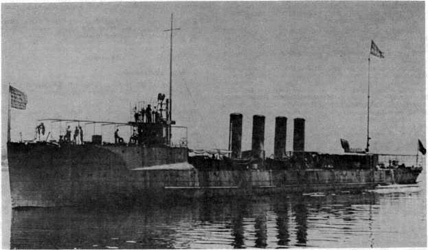 |
|
The four stacker destroyer USCGC Henley (DD-39) September 1912.
|
|
|
|
USCGC Fanning (DD-37)
at the October 1912 Naval Review. |
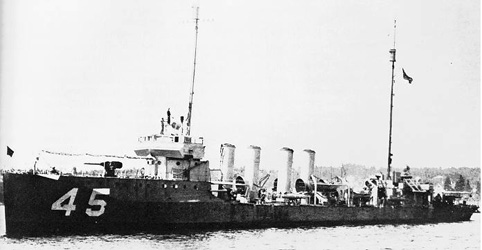 |
|
The Navy transferred the USCG Downes (DD-45) to the Coast Guard in April of 1924. (Darryl Baker, Vallejo Naval and Historical Museum). |
Sande also served aboard the US Coast Guard cutter Nemaha (WSC-148) which was an “Active Class” patrol boat, and the USCGC Legare (WSC-144) which in 1929 pursued and seized a rum runner, the Flor Del Mar, which was promptly abandoned by its crew.
On June 19th 1931, Sande was transferred to the Coast Guard Station at New London, Connecticut and given command of the USCG Patrol Boat 231. “While my father was skipper of Patrol Boat 231 he married my mother Viola Edgcomb on August 2nd 1932,” Ted recalls. “My mother’s family came to the North American British Colonies in 1637 from Devon, England, and first settled in Upper Massachusetts (now the State of Maine) then relocated to New London in the early 1670s.”
|
|
|
US Coast Guard Patrol Boats circa 1930. (USCG Photo). |
During his years of playing cat and mouse with the rum boats Sande made a number of arrests and received several notices in New York papers for outsmarting rum runners in the waters around Staten Island, Arthur Kill, Kill van Kull, and the Upper and Lower Bays. “I think that he must have been a very skillful sailor to have outwitted these guys,” Ted explains, “since the rum runners usually had very powerful engines and could typically outrun a standard patrol boat.”
|
|
|
The Apprehension of a Rum Runner. (Library of Congress). |
The 1930s were dominated by the Great Depression, which affected the Coast Guard as well as the other uniformed services. On June 15th 1933, President Franklin D. Roosevelt issued Executive Order 6169 which provided for the temporary transfer of a limited number of commissioned officers and warrant officers from the Army, Navy, Marine Corps and Coast Guard to the Civilian Conservation Corps (CCC) for duty in administering that major public works employment program. In November 1933, while his family was living in Groton, Connecticut, Sande was officially transferred to the War Department where on December 13th 1933 he was assigned to the 5th CCC District, 190th Supply Company at Fort H. G. Wright, New York as an assistant to the district supply officer.
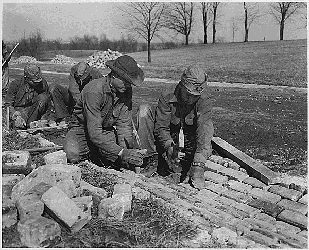 |
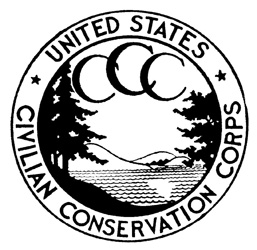 |
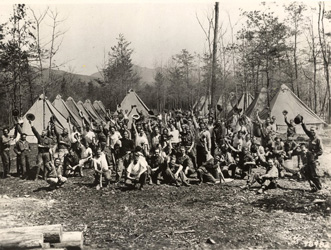 |
| Civilian Conservation Corps Road Construction 1933. | The 1930s CCC Insignia. | Civilian Conservation Corps - Roosevelt’s Forest Army |
Then in June 1937 when the 5th District closed, he was transferred to the 3rd CCC District at Fort Devens, Massachusetts and the Sande family moved to Ayer, Massachusetts. After two years at Fort Devens he was finally transferred back to the Coast Guard on September 30th 1939 and assigned to the USCGC Duane, out of Boston, one of the service’s largest ocean-going cutters. We can only imagine how good the sea breeze must have felt to him after 6 years ashore!
|
|
|
USCGC Duane (WPG-33). (US Coast Guard March 1943). |
But after only two weeks aboard Duane on October 13th 1939, he was transferred to the Pequot at New London, CT. A year later, in October of 1940 he left the Pequot and was temporarily assigned to the USCG Diligence (WSC-135) a 125' diesel-powered Coast Guard cutter at Two Harbors, Minnesota. Sande was sent to Duluth at that time to oversee the completion of a flotilla of wood-hulled patrol boats and bring them to New London through the Saint Lawrence Seaway. “As a young boy I distinctly remember his Duluth trip because on the way through the St. Lawrence Seaway, the flotilla stopped at Montreal, where he bought me the most wonderful gift a seven-year old could ask for - a complete child-size Northwest Mounted Police uniform, with all the trimmings including a Sam Browne belt, toy pistol and holster. (I was ready to save Jeannette McDonald, but Nelson Eddy had an unfair advantage.)
|
|
|
|
USCG Cutter Diligence WSC-135). |
A US Coast Guard Flotilla. |
On August 1st 1941, only four months before the attack on Pearl Harbor, upon completion of this temporary duty assignment he was given orders to return to the Pequot. With the entry of America into World War II, the Coast Guard became part of the U.S. Navy for the duration.
Ted writes of visiting his father during his Pequot days, “During the Second World War, I can only recall being with my father four or five times, usually when he came to port for refueling or repairs. On these occasions, mother and I would join him and sometimes I had the opportunity to stay on board Pequot for a few days. So there I was at 10 years old bunked in the chiefs’ quarters in the forecastle. You can imagine how delighted those guys were to have the Captain’s kid in their midst! That’s when I got to know “Bridges,” who had a great, earthy sense of humor. I think he came from Maine, and “Ski” who had that nickname because nobody could pronounce his full Polish last name. I associate him specifically with the engine room, which I couldn’t enter without his permission. Those two great reciprocating engines and the catwalks were spotless and gleaming under his care. On the lowest deck of the engine room was the thwart-ship fire room where stokers kept the boilers fed with coal. I don’t know how those men stood it, the heat was intense and the shoveling unremitting.”
|
|
|
The Black Gang below decks. (Lou Carhart). |
“One of the ironies of my staying in the chiefs’ quarters was that my father abhorred profanity and the chiefs took a more liberal view. I was told that swearing was not tolerated around the “Old Man”, as the crew called him, at least in my presence. Needless to say, my education was considerably enriched by living up forward,” Ted adds. “I never heard my father swear, but I sure did know when he was displeased. He was fluent in Norwegian, German, and English and generally you couldn’t detect an accent in his English, except when he got mad and then “w” and “v” somehow got reversed, a sign that it might be a good time to be somewhere else.”
During the war years career Coast Guardsmen rose up to ranks that they would not have thought possible in the peace time service. Sande was made a permanent Warrant Boatswain on December 1st 1939, he was promoted to Chief Warrant Boatswain on March 12th 1942, and to Lieutenant (Junior Grade) on July 22nd 1942.
Lieutenant W. T. Murphy, the captain of the Pequot under whom Sande served before he took command of the ship, wrote in his endorsement of the promotion to Lieutenant, “The Commanding Officer, PEQUOT, has known Chief Boatswain Sande in the service for 21 years…” “That would take their acquaintance back to the year of his initial enlistment in the Coast Guard. My impression is that they were friends of long standing and that Murphy, the older man, may have been a mentor to my father at various times during his career,” Ted explains.
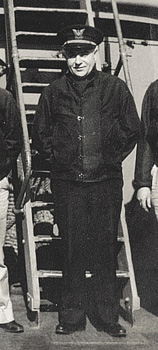 |
| Captain L.A. Sande aboard the Pequot March 1945. (Calamaio family). |
After assuming command of Pequot Sande became a full Lieutenant on May 25th 1943, a permanent Chief Warrant Boatswain (as a Lieutenant) on February 27th 1945, and a Lieutenant Commander on August 18th 1945, which was made permanent on February 10th 1950.
“Perhaps my father’s favorite dish was “Lobscouse”, a rich lamb stew that was a signature Hamburg sailors’ meal that he must have acquired a taste for during his early merchant marine days. He loved blueberry pie,” Ted remembers. “ And, he passed on to me a taste for the turkey’s tail – we call it the “parson’s nose”. I understand that when he was away from the Pequot for Thanksgiving or Christmas, he left instructions with the cook to set aside the turkey tails for him and he made a bee line for the galley when he came back on board to retrieve his platter of delicacies. I don’t think he had to worry about much competition for them.”
Five weeks after V-E day Sande was relieved of command of the Pequot by Lieutenant William P. Butler on June 16th 1945. His remaining Coast Guard service was with the Bureau of Marine Inspection, first at Providence, Rhode Island from September 1945 to June 1947, and then in New Orleans, Louisiana from July 1947 until his retirement in June of 1951. His duties consisted of carefully inspecting ships to ensure that they were in compliance with all Coast Guard regulations.
|
|
|
Lars Anton Sande 1951. (Ted Sande). |
Just before his retirement, in April 1951, Sande passed the Coast Guard exams and received his U.S. Merchant Marine Officer license as Master, for steam and motor vessels of any gross tons upon any ocean.
“He had great plans to return to sea with the Merchant Marine but he didn’t live long enough to use his Master rating,” Ted writes. Lars Anton Sande passed away at 57 from heart failure during surgery for advanced pancreatic cancer on November 10th 1952. He was buried with full military honors at the Starr Cemetery, Groton, Connecticut. Viola Edgcomb Sande died in 1977 at age 84 and was buried next to her husband.
According to Ted Sande, “I knew nothing of the Pequot’s top secret cable laying mission and my father never spoke of it.”
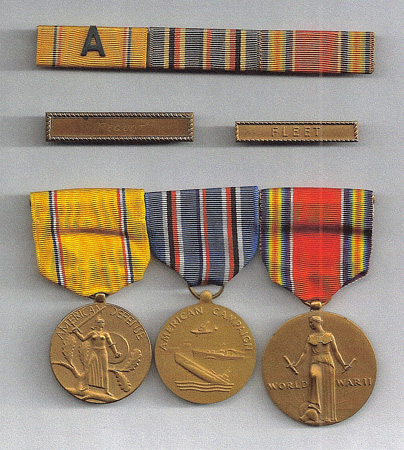 |
|
Captain Sande’s Decorations. (Ted Sande). |
Left - American Defense Service Medal WWII
Center - American Campaign Medal
Right - World War II Victory Medal
The “Fleet “bar was issued by the Coast Guard for service on the high seas while regularly attached to any vessels of the Atlantic fleet.
The "A" Device was
awarded for duty in actual or potential belligerent contact with
Axis Powers in the
Atlantic Ocean between June 22nd and December 7th, 1941.
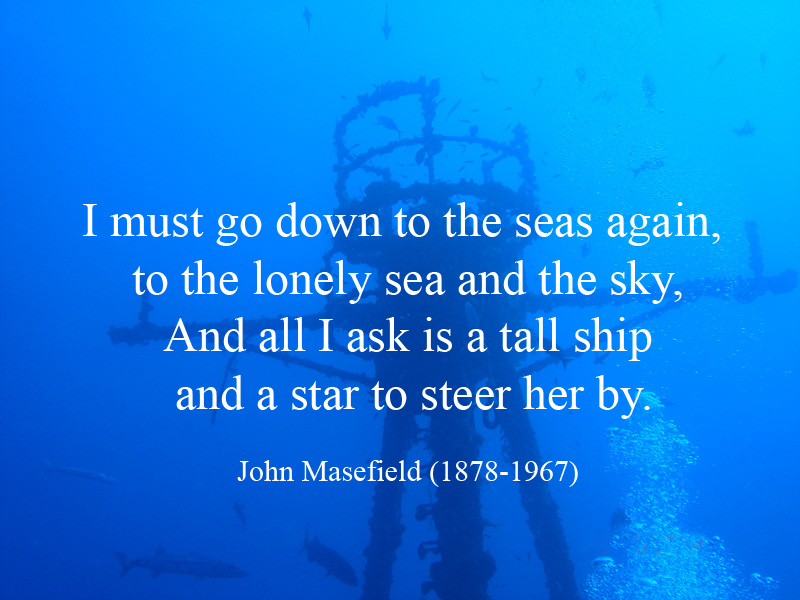 |
|
The mast of the USCGC
Duane off Key Largo, Florida. |
Every effort has been made to trace and acknowledge copyright. The authors would welcome any information from people who believe their photos have been used without due credit. Some photos have been retouched to remove imperfections but otherwise they are true to the original.
FEEDBACK
If you have comments or queries specifically
about the Pequot or Captain Lars Sande, please contact
Chip Calamaio
chipaz@cox.net, Phoenix, Arizona,
USA. (H) 602-279-4505.
Click here to go to the Pequot Main Page.
Research and design: Chip Calamaio and Richard Walding